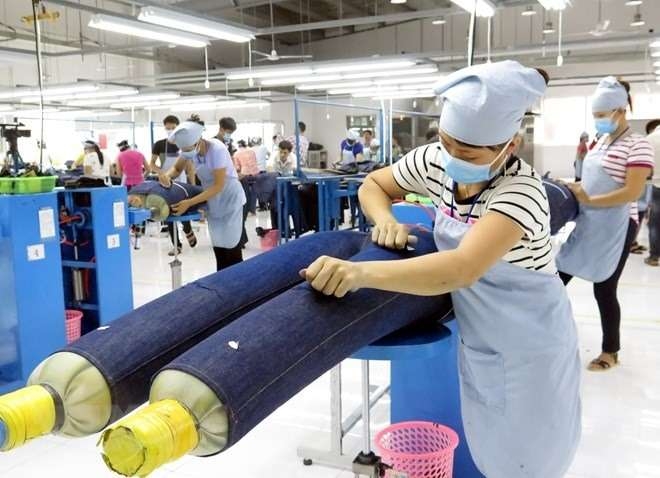CPTPP to create impetus for textile, footwear industries
 |
| Vietnam’s garment and textiles export turnover hit US$25.2 billion in the first 10 months of 2018. - VNA/VNS Photo |
One of the key contents of the CPTPP is the removal of 95-98 per cent of tariff lines as soon as the agreement enters into force. The remaining tariff lines will be cut over the next seven years, moves predicted to aid the growth and export turnover of the two industries.
Vietnam’s garment and textiles export turnover hit US$25.2 billion in the first 10 months of 2018, up 17.1 per cent year-on-year. Meanwhile, footwear exports were valued at $13 billion, 9.7 per cent higher than in the same period last year.
The export turnover of garment and textiles recorded growth in key markets such as the US, the EU, the Republic of Korea, China and member nations of the CPTPP.
According to the Vietnam Textile and Apparel Association (VITAS), the CPTPP will help Vietnam accelerate its growth and make the export market more balanced. The zero-per cent tariffs will help the country’s textile and garment industries expand market share in countries with high tax rates.
Vietnam’s export turnover of the industry is forecast to reach $35 billion in 2018. The figure is expected to climb to $50 billion in 2025.
Experts, however, also pointed out difficulties facing the sector.
The CPTPP sets strict requirements on product origin, a big challenge for Vietnamese enterprises and the textile and garment and footwear sectors, as they are heavily dependent on material sources imported from China, India and other ASEAN countries.
Truong Van Cam, Vice President of VITAS, said the current source of materials for Vietnam’s textile and garment industry is limited.
The US, the EU and Japan are now the three largest export markets of Vietnam.
Vietnamese exporters have been advised to continue promoting the support industry, and ensure they can prove the origin of raw materials for production.
For the footwear industry, the CPTPP is also an opportunity for exporters to expand to Chile, Australia, New Zealand, Mexico, Canada and Japan.
Experts said Vietnamese footwear exporters have opportunities to sell products in Japan, a key market for the sector.
If enterprises know how to make full use of the CPTPP, growth in this market is likely to increase, they stressed.
Vietnamese businesses will also have more opportunities in Canada, which will impose a zero import tariff on both leather shoes and handbags immediately.
However, to benefit from this agreement, footwear enterprises will have to overcome considerable challenges.
According to Nguyen Duc Thuan, Chairman of the Vietnam Leather and Footwear Association (Lefaso), businesses should explore regulations related to customs procedures and logistics of CPTPP member countries, while improving the quality of their products.
The Government should support enterprises by creating a fair playground and minimising administrative procedures to protect Vietnamese firms in the domestic market, Thuan said.
Vu Duc Giang, Chairman of the Board of Directors of Bao Minh Textile JSC, said all production lines of the firm use the most advanced equipment from famous global brands.
Each year, Bao Minh provides more than 35 million metres of high quality fabric for the fashion brands.
The firm has contributed to increasing the supply of raw materials in the country, helping businesses reduce imports of raw materials.
What the stars mean:
★ Poor ★ ★ Promising ★★★ Good ★★★★ Very good ★★★★★ Exceptional
Related Contents
Latest News
More News
- PM urges Ho Chi Minh City to innovate and remain Vietnam’s economic locomotive (November 26, 2025 | 15:29)
- Experts chart Vietnam's digital finance path: high hopes, high stakes (November 14, 2025 | 10:56)
- Vietnam’s seafood imports surge 30 per cent in first 10 months (November 10, 2025 | 19:35)
- Vietnam’s durian exports hit $1 billion milestone (October 30, 2025 | 17:41)
- Beyond borders: Sunhouse and new era of Vietnamese brands on Amazon (October 28, 2025 | 10:46)
- Record-breaking trade fair set to open in Hanoi (October 15, 2025 | 15:59)
- Timber sector seeks solutions to VAT refunds (October 14, 2025 | 18:58)
- Tether explores investment prospects in Vietnam’s digital asset sector (October 10, 2025 | 18:09)
- Vietnamese investors pour nearly $847 million into overseas markets in nine months (October 08, 2025 | 18:42)
- Vietnam amends Law on Civil Aviation to create drive airport investment (October 03, 2025 | 18:29)

 Tag:
Tag:






















 Mobile Version
Mobile Version